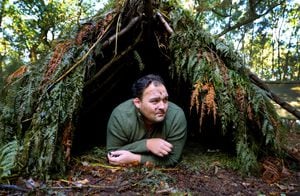Rob Golledge: How I survived a night in the wild
In a world full of mod cons with everything readily available as and when we need it, Weekend challenged Rob Golledge to go back to basics. . .

It was the sound of two foxes fornicating which did it for me. I could cope with the blanket of leaves that was my mattress for the night.
My shelter of twigs, branches, and freshly plucked bracken was rather cosy. In fact, I was rather proud of it.
And I wasn’t fazed by the prospect of rain sweeping in from the west. I had a Pac-a-Mac.
But what I wasn’t prepared for was the screeching cries of an amorous vixen and her frisky red-haired lover, set amongst an orchestra of owls at two in the morning.
You don’t hear of Ray Mears or Bear Grylls being kept awake by a midnight sex show, do you?
Yet here I was, deep in supposedly tranquil woodland on the Derbyshire and Leicestershire border, being treated to the animal kingdom’s version of Moulin Rouge.
Don’t call me Nature Boy!
And while I struggled for sleep over the next four hours, I started to question where it had all gone wrong?
Yet soon I’d be asking myself, ‘could this be the greatest thing I’ve ever learnt?’
I’d been sent to Spring Wood, near East Midlands Airport, to take part in a bushcraft practitioners survival skills course.
Messrs Mears and Grylls have helped fuel a surge of new thrillseekers looking to live life on the wild side.
And I’d been tasked to find out why.
“It is alive, it’s creative, it’s inspiring,” says Dave Watson.
Dave is a bushcraft survival instructor with more than 20 years experience who bears a strong resemblance with TV comedian Hugh Dennis, but is actually funny.
We meet in a coppice where steam billows out of an impressive wooden roundhouse.
Next to it a semi-circle of logs have been turned into makeshift benches.
And a crisp breeze sweeps through the clearing with the late summer orange sun peeking through the canopy of birch trees.
“The most important thing to do first of all is to assess the landscape,” says Dave.
“Find something that is really flexible. Have a look and see what can support you directly for shelter, food, fire, and water.”
He sends me and a team of seasoned outdoor instructors into the 100-acre wood.
I felt as much use as Winnie the Pooh.
After 10 minutes of trodding through the undergrowth, and inanely gazing at vegetation, I returned empty handed.
It turns out just about anything in the wild can help you survive.
Tree branches can be used to create shelters, old logs for firewood, nettle stems for cordage, sap for insect repellent.
“There’s a lot out there,” says Dave.
“It’s like learning a language.
“You have to learn to read the landscape.”
With our minds broadened and our imaginations running wild, it was time to make our homes for the night.
Deeper into the woods were a series of shelters dotted around a campsite.
Some were more than 10 years old and looked like the sort of thing SAS commandos would emerge from while on ops.
Making it was fairly straight forward.
First we had to make sure we found a relatively flat area – we didn’t want puddles building up.
And we had to ensure the back of the shelter was facing the direction of the wind to avoid a chilly night.
Ensuring all the natural resources we required were nearby was also a must.
A thick, long branch makes for the spine of the shelter. That then rests on two interlocking forked branches that gives us our frame.
Then the job turns to creating the coverings.
Sticks, branches and lots of bracken leaves are then added to coat the structure.
And it is important to layer and weave the leaves so rain water cannot build up or drip through.
Leaves and vegetation can then be used to soften up the ground inside the shelter.
It may not look like much – and in reality it is just sticks and leaves – but it is a solid home for the night out of the wind and rain.
For someone who has sat behind a desk for 10 years, it was enough to build up a sweat.
Though I admit it was extremely satisfying.
My pampered journalist’s hands hadn’t been grazed, scuffed, or chafed like that since playing in goal during lunch time football matches on my school’s gravel tennis courts.
Assembling IKEA furniture was not a patch on this stuff.
But the ultimate man moment was to come later.
As we caught our breath, I asked Dave about the increased interest in bushcraft and survival skills.
In a world full of computers, gadgets, and services at the click of a button, he worries about the lost basic skills children of the pre and post-war Britain would have grown up with.
But he also believes that modern thinking is beginning to turn the corner – in part inspired by the likes of Ray Mears and Bear Grylls.
“An awful lot of education is based on memorising. That is not learning,” he says.
“Many of the things that society sells us as real are anything but.
“I have learnt most of the key principles about life from what I have learnt out here.
“I am not interested in people hiding behind what I have said. Real learning is about finding things out for yourselves and by what you have found.
“The skills you learn out here are skills for life.
“People have almost forgotten the ability to think for themselves, be inventive, or look after themselves.”
Dave teaches a wide range of people – from instructors to school children.
More and more outdoor centres are opening and more and more schools are engaging with bushcraft survival skills.
“A lot of this really cuts across young people,” he says.
“There is a sense of adventure. And when they realise that they can make a whistle out of wood, use a knife properly, and make their own shelters, you can see their eyes open and them realise that learning is not just about reading a book or remembering things that are written down.
“They realise for the first time that they can try different things to find out what works, and how to solve problems.
“Ray Mears was a big trigger. People like Bear Grylls are now the ‘in thing’.
“My main push is to get more of this in education and society.
“You can take a vast proportion of the curriculum but do it in real terms.
“People, especially young people, need something tangible.
“They need that connectivity. It also instils confidence.
“I focus a lot on truly living in the wild. It makes people think what they need, where they are going, and where they can find it.
“Some say it is a mystic art – but we can all do it. We just need to reconnect with our instincts. It is not rocket science. It is logic.”
Over the rest of the course we learnt basic knife skills, how to turn nettle stems into threads to make rope, how to filter water, and how to make fire.
Until you have done it, you will not appreciate the exhilarating feeling of creating flames out of nothing but your hands and a few pieces of wood.
Can there be anything more manly?
Using the prehistoric technique of a bow drill – a wooden bow with string attached to either end – friction is created between two pieces of wood rubbing against each other.
This produces a burning ember.
That can then be used to create a bigger fire.
From the ashes of two pieces of wood repeatedly rubbing together, a heat source is created that can then set dried sticks and vegetation alight.
Fire has a mesmerising quality that has fascinated man since the conception of our species.
That night I was able to keep myself warm, cook my dinner, and create light in the darkness – all from that little ember.
If that isn’t fulfilling, then I don’t know what is.
Apart from a brief spell in the Scouts and the odd camping holiday, I’ve never fully appreciated life in the great outdoors.
That night gave me a sense of satisfaction for which I simply have no comparison.
It’s not glamorous. It’s not lavish. But it is simple.
There was no distractions from Facebook or Twitter. No ordering that night’s supper in from Deliveroo. No finding the solution to DIY problems by watching YouTube videos or calling in a tradesman.
Just me, my hands, my mind, and the natural resources of the world.
I had conquered a very small battle.
That night I led in my shelter and looked up to the stars. I was knackered. My heart pounded. I could see my breath condensate in the cold. Slowly my eyelids started to droop.
Then the midnight entertainment started.
Oh, for fox sake!
l If you are interested in bushcraft skills go to woodlandsurvivalcrafts.com





